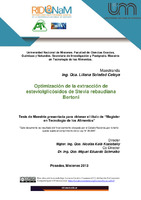| dc.rights.license | Licencia de Creative Commons Reconocimiento-NoComercial-CompartirIgual 4.0 Internacional (CC BY-NC-SA 4.0) | |
| dc.contributor | Kolb Kozlobsky, Nicolás | |
| dc.contributor | Schmalko Radichowski, Miguel Eduardo | |
| dc.creator | Celaya, Liliana Soledad | |
| dc.date.accessioned | 2020-11-29T14:52:18Z | |
| dc.date.available | 2020-11-29T14:52:18Z | |
| dc.date.issued | 2013-12-01 | |
| dc.identifier.citation | Universidad Nacional de Misiones. Facultad de Ciencias Exactas, Químicas y Naturales. Secretaría de Investigación y Postgrado. Maestría en Tecnología de los Alimentos (2013). Optimización de la extracción de esteviolglicósidos de Stevia rebaudiana Bertoni (Tesis de Maestría) / Director, Mgter. Ing. Qco. Nicolás Kolb Kozlobsky; Co-Director, Dr. Ing. Qco. Miguel Eduardo Schmalko; Maestranda, Ing. Qca. Liliana Soledad Celaya. Posadas (Misiones): UNaM. FCEQyN. SIyP. MTA. 162 p. | es_AR |
| dc.identifier.other | TM-002 | |
| dc.identifier.uri | https://hdl.handle.net/20.500.12219/2780 | |
| dc.description | Fil: Celaya, Liliana Soledad. Universidad Nacional de Misiones. Facultad de Ciencias Exactas, Químicas y Naturales. Secretaría de Investigación y Postgrado. Maestría en Tecnología de los Alimentos; Argentina. | es_AR |
| dc.description.abstract | En el presente trabajo, se estudió la influencia de la temperatura y las
proporciones relativas de etanol y agua en el solvente de extracción, en lecho
percolador, de los componentes edulcorantes principales de las hojas molidas de
Stevia rebaudiana Bertoni. Los ensayos se realizaron a escala laboratorio,
partiendo de un material vegetal con alta proporción de Rebaudiósido A, el
componente de mejores características edulcorantes.
El rango de temperaturas estudiadas fue de 30 ºC a 70 ºC, mientras que el
rango estudiado de mezclas etanol:agua estuvo entre 0:100 y 100:0 desde agua
pura a etanol puro. A partir de los resultados obtenidos, se realizó un tratamiento
estadístico con el fin de determinar las condiciones óptimas de operación.
Complementariamente, se determinaron las curvas de solubilidad del
Esteviósido, del Rebaudiósido A y de mezclas de Esteviósido y Rebaudiósido A en los mismos rangos de temperaturas y proporciones etanol:agua utilizados en las experiencias de extracción.
En cuanto a la eficiencia de la extracción, ésta aumentó linealmente con la
temperatura y fue mayor cuando el porcentaje de etanol en el solvente mixto se
encontraba entre el 30 y 70 %. Los resultados obtenidos fueron concordantes con
las solubilidades de Esteviósido y Rebaudiósido A en estos solventes mixtos;
difirieron en solvente acuoso, posiblemente debido al fenómeno de cosolubilización de los glicósidos en agua. Los extractos de mayor pureza se
obtuvieron con etanol:agua 70:30. Sin embargo, no se pudo establecer la
dependencia de la pureza con la temperatura y el solvente mixto utilizando una
ecuación de segundo orden. En condiciones óptimas (etanol:agua 36:64 y 70°C),
el porcentaje de Esteviósido recuperado fue del 93,46 % y el de Rebaudiósido A,
del 87,50 %, cuando el tiempo de operación fue de una hora y obteniendo 1 L de
extracto bruto por cada 200 g de hojas secas molidas. | es_AR |
| dc.description.abstract | In the present work, the influence of temperature and relative ratios of
ethanol and water in the extraction solvent, in percolator bed, of the main
sweetener components of ground leaves of Stevia rebaudiana Bertoni were
studied. Assays were performed at laboratory scale, from plant material with high
proportion of Rebaudoside A, the component carrying the best sweetener
characteristics.
The range of temperatures studied was of 30 ºC to 70 ºC, while the scope
of the ethanol:water varied from 0:100 up to 100:0 from pure water to pure ethanol.
From the results obtained, a statistical treatment was performed with the aim of
determining the optimal conditions of operation.
In addition, and as complimentary to this work, solubility curves of
Stevioside, Rebaudioside A and mixtures of Stevioside and Rebaudioside A in the
same ranges of temperature and proportions ethanol:water used in the extraction
experiences were determined.
As for the efficiency of the extraction, this increased linearly with
temperature and is greater when the percentage of ethanol in the mixed solvent fell between 30 and 70 %. The results obtained were in agreement with solubilities of Stevioside and Rebaudioside A in mixed solvents. They differed in aqueous
solvents, probably due to the phenomenon of co-solubilization of glycosides in
water. The extracts with greater purity were obtained with ethanol:water 70:30.
However, the dependence of purity with temperature and the mixed solvent could
not be established using a second degree equation. In optimal conditions
(ethanol:water 36:64 and 70 °C), the percentage of recovered Stevioside was
93,46 % and of Rebaudioside A was 87.50 %, when the operation time was one
hour, obtaining 1 liter of crude extract from 200 g of ground dry leaves. | es_AR |
| dc.format | application/pdf | |
| dc.format.extent | 3 MB | |
| dc.language.iso | spa | es_AR |
| dc.publisher | Universidad Nacional de Misiones. Facultad de Ciencias Exactas, Químicas y Naturales. Secretaría de Investigación y Postgrado. Maestría en Tecnología de los Alimentos | es_AR |
| dc.rights | Atribución-NoComercial-CompartirIgual 4.0 Internacional | * |
| dc.rights.uri | http://creativecommons.org/licenses/by-nc-sa/4.0/ | * |
| dc.subject | Stevia rebaudiana Bertoni | es_AR |
| dc.subject | Esteviolglicósidos | es_AR |
| dc.subject | Extracción | es_AR |
| dc.subject | Esteviósido | es_AR |
| dc.subject | Rebaudiósido A | es_AR |
| dc.title | Optimización de la extracción de esteviolglicósidos de Stevia rebaudiana Bertoni | es_AR |
| dc.type | info:eu-repo/semantics/masterThesis | es_AR |
| dc.type | info:ar-repo/semantics/tesis de maestría | es_AR |
| dc.type | info:eu-repo/semantics/acceptedVersion | es_AR |




